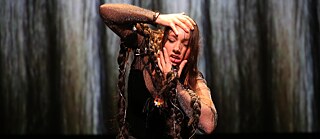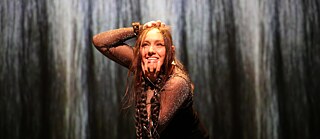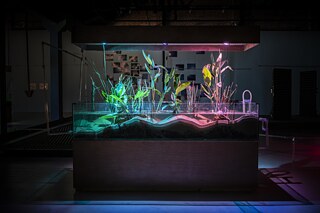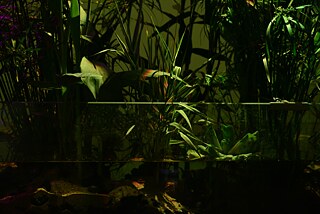The Launch of New Nature
Staying With the Soil

New Nature’s launch offered a generative starting point for reconceptualizing the relationship between technology and the environment.
By David Shaw
As curator Samara Chadwick described in her opening remarks to participants, the goal of New Nature, an immersive Media and Climate Science Exchange between Canada, Germany, Mexico, and the United States, is to “set out to establish fertile soil for new ideas to emerge.” The sentiment is an important one, but the earthy metaphor felt almost anachronistic in the context of an event whose environment was entirely digital: In response to the ongoing global COVID-19 pandemic, both the public facing events as well as the participant workshops of the New Nature project took place as a series of Zoom meetings, adding a new layer of technological mediation to an event that was already saturated with the impact of technology on how we represent the world to each other.
There’s a kind of knotted symbolism here that became a recursive theme of the participants’ conversations: The project constituted an effort to bring people together at a time when physical proximity is inextricably linked, in the global public imaginary, with the transmission of disease. The question of how to bring people together while remaining physically distant has taken on a heightened sense of urgency during the pandemic, and many of New Nature’s participants’ works demonstrated the central role that technology can play in developing new modes of bringing people both closer to each other and their environment.
Deep Swamp
This tension between technology and the environment is neatly captured in the work of Australian-born artist and environmental engineer Tega Brain, who spoke with other New Nature participants about her work at the intersection of ecology, data systems, and infrastructure. Her recent project Deep Swamp, for example, which Brain describes as a “triptych of semi-inundated environments that gather together wetland life forms and artificially intelligent software agents,” consists of three separate wetland tanks whose environmental conditions are each moderated by a unique artificial intelligence program. Each of the “software agents” engineers the conditions of their respective tanks in pursuit of a different goal: one aims for “a natural looking wetland,” the second “is trying to produce a work of art” and the third “simply wants attention.” The software that governs these three approaches is refined through a process of deep learning: each “agent” parses a vast database of tagged imagery in order to develop a sense of their goal, and then adjusts and monitors the conditions of their tank accordingly. In this sense, each of the three tanks is sustained not through a rigid orientation toward computing the “ideal” environmental conditions, but rather through a lively process of negotiation between environment and technology.
With this sense of negotiation in mind, Brain’s Deep Swamp can be seen to illustrate the shortcomings of thinking about environments through the metaphor of the “system.” As Brain observes, “a systematic view of the environment connotes it as bounded, knowable and made up of components operating in chains of cause and effect.” The continued circulation of terms like “ecosystem” suggest the extent to which environments are often reductively construed as a set of quantifiable data points, such that projects of environmental conservation tend to implicitly assume that their goal is to achieve a kind of quantifiable equilibrium, as if the environment were a kind of math equation that had been knocked out of balance. In place of the too-rigid systematic approach to environment, Brain’s work asks us to consider a new narrative of ecological sustainability, in which environments grow and change alongside technology through an ongoing process of negotiation.
Decolonizing the Anthropocene
This effort to rearticulate dominant ecological narratives is a through-line in the work of several New Nature participants, including Heather Davis, whose work on decolonizing the Anthropocene challenges the universalizing assumptions that the term Anthropocene implicitly raises: While the notion of the Anthropocene, or “Age of Man,” aims to highlight the increasingly central role of human activity in global environmental degradation, as Davis points out, its broad gesture to humanity as a singular monolithic entity actually ends up obfuscating the power dynamics that are underlying drivers of the present climate crisis. In particular, for Davis, the term obscures the foundational role that colonialism played and continues to play in our understanding of the environment. As she describes in an essay with Metis anthropologist Zoe Todd, the “ecocidal logics that now govern our world are not inevitable or ‘human nature’, but are the result of a series of decisions that have their origins and reverberations in colonization.” In her work, Davis maps these reverberations in order to challenge the dominant and universalizing narrative of the Anthropocene.
Primarily, for Davis, colonialism should be understood to catalyze a new kind of relationship between the colonizer and the land and people they colonize: As she and Todd describe, “[w]hat settler colonialism, and its extensions into contemporary petrocapitalism, does is a severing of relations. It is a severing of relations between humans and the soil, between plants and animals, between minerals and our bones.” This “severing of relations” becomes the governing logic of the Anthropocene, where the colonial impulse to reframe the planet as a stockpile of inert resources waiting to have their value extracted leads in turn to widespread environmental devastation with which we are all increasingly familiar.
Importantly, rather than taking the universalizing shortcomings of the Anthropocene as grounds for rejecting the term entirely, Davis instead argues that “by making the relations between the Anthropocene and colonialism explicit, we are then in a position to understand our current ecological crisis and to take the steps needed to move away from this ecocidal path.” The tethering of the Anthropocene to its roots in colonization forces a powerful shift in how we understand the relationship between humans and the environment: If we take seriously the notion that the Anthropocene is a call to action for humanity to recognize and rectify its damaging impact on the environment, than Davis’ work makes a compelling case for the reparation of colonial violence as a critical first step toward environmental justice.
Making Kin with the Machines
The role of colonialism in severing relations to the nonhuman world is further explored by New Nature participant Suzanne Kite, an Oglála Lakȟóta performance artist, visual artist, and composer whose work examines the relationship between technology and indigenous knowledges. In a paper called “Making Kin with the Machines” coauthored with Jason Edward Lewis, Loelani Arista, and Archer Pechawis, Kite asks, “how do we as Indigenous people reconcile the fully embodied experience of being on the land with the generally disembodied experience of virtual spaces? How do we come to understand this new territory, knit it into our existing understanding of our lives lived in real space, and claim it as our own?” Throughout the piece, Kite and her coauthors argue that many indigenous modes of knowledge provide generative frameworks for modelling the relationship between humans and artificial intelligence, but that “colonial narratives have failed to understand or simply dismissed” those knowledges. In particular, Kite describes the Lakota concept of wakȟáŋ, which she translates as “sacred,” and which she says serves as the basis for relationality to the nonhuman world in the Lakota cosmology. So while Davis’ work describes how Western colonial epistemologies tend to figure the nonhuman world as a resource waiting to be exploited, Kite explains how the Lakota concept of wakȟáŋ positions the nonhuman world not as a flat and static set of resources, but rather as a space of unknowable animacy that needs to be engaged with a sense of mutual respect.

With that in mind, we can return to the “fertile soil" analogy offered by Chadwick in her opening remarks. While the phrase was intended to be understood metaphorically, Kite’s suggestion to take seriously the “ontological status” the broader network of components through which technologies emerge gives the phrase a generatively literal new meaning: At risk of overburdening an already fairly worn idiom, the “fertile soil” from which new ideas will emerge will be a compost of Zoom meetings, deep learning algorithms, and decolonized epistemologies, as well as the actual material infrastructure through which each of these things are developed and sustained; the stones that Kite’s work draws our attention to, as well as the actual soil in the tanks of Tega Brain’s Deep Swamp project. As we continue to grapple with the global pandemic, creating the conditions under which new stories can emerge will mean remaining cognizant of the broad assemblage of things, both organic and not, that constitute our environment and help us find our place within it.

